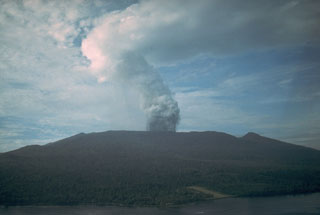Report on Karkar (Papua New Guinea) — February 1979
Scientific Event Alert Network Bulletin, vol. 4, no. 2 (February 1979)
Managing Editor: David Squires.
Karkar (Papua New Guinea) Intermittent explosions and steady seismicity continue
Please cite this report as:
Global Volcanism Program, 1979. Report on Karkar (Papua New Guinea) (Squires, D., ed.). Scientific Event Alert Network Bulletin, 4:2. Smithsonian Institution. https://doi.org/10.5479/si.GVP.SEAN197902-251030
Karkar
Papua New Guinea
4.647°S, 145.976°E; summit elev. 1839 m
All times are local (unless otherwise noted)
During February, four additional phases of heightened eruptive activity took place. Audible explosions ejected ash and rock fragments on 1, 8, 15-16, and 24 February, accompanied by felt earthquakes or periods of felt tremor. Frequent flashing arcs, associated with strong ejections of ash and blocks, were observed 7-9 February. Between the phases of strong activity, Karkar usually emitted moderately dense white vapor with intermittent light ash content, usually accompanied by weak rumbling and roaring.
Since the eruption began on 12 or 13 January, seismic activity has been generally steady, at levels much lower than during the peak of pre-eruptive seismicity in October 1978 (figure 1). Banding of periodic stronger and weaker tremor had been sporadically evident. Discrete (B-type) seismic events began to be recorded in greater numbers during the second half of February.
Geological Summary. Karkar is a 19 x 25 km forest-covered island that is truncated by two nested summit calderas. The 5.5 km outer caldera was formed during one or more eruptions, the last of which occurred 9,000 years ago. The steep-walled 300-m-deep, 3.2 km diameter, inner caldera was formed sometime between 1,500 and 800 years ago. Cones are present on the N and S flanks of this basaltic-to-andesitic volcano; a linear array of small cones extends from the northern rim of the outer caldera nearly to the coast. Recorded eruptions date back to 1643 from Bagiai, a pyroclastic cone constructed within the inner caldera, the floor of which is covered by young, mostly unvegetated andesitic lava flows.
Information Contacts: C. McKee, RVO.

